My chickens are garbage disposals on legs – they eagerly gobble up any and every kitchen scrap I toss their way.
They go crazy when they see me trotting over with a bucket of food scraps, acting like it’s better than chicken feed.
I learned that the hard way as a newbie farmer when I found a container of moldy leftovers in the back of my fridge.
Thinking “chickens eat anything,” I served up the fuzzy feast.
Well, their feathers ruffled in disgust and they squawked in offense at the rotten meal.
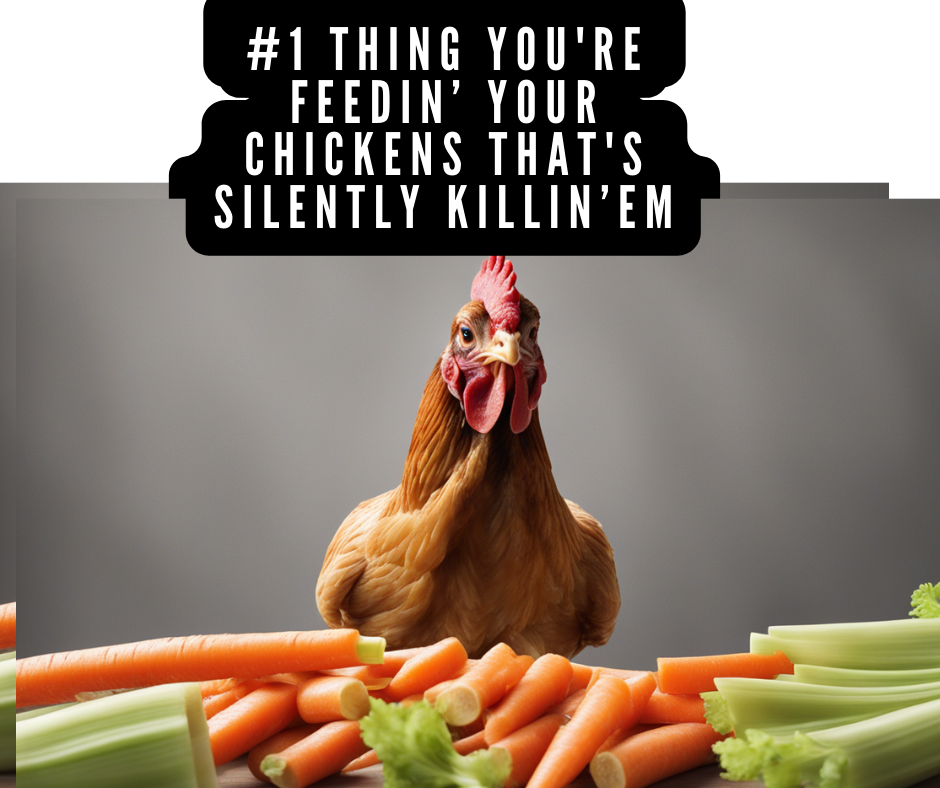
That fiasco taught me I had a lot to learn about proper chicken cuisine if I wanted harmonious hens.
Now, after raising multiple flocks over the years, I want to help you avoid similar mistakes.
I’ve compiled this list of over 15 things you should never feed your flock, no matter how harmless they seem.
Believe me, ruffled feathers and chicken fits over food are no fun:
Table of Contents
Moldy Feed

Moldy feed can contain aflatoxins, mycotoxins and other fungal toxins really dangerous for chickens over time.
I once bought a discounted bag of layer pellets that had some clumping and strange smells in the bottom.
Not realizing it was molded, I went ahead and filled the feeder for my flock of 12 hens.
Over the next few days over half my flock got extremely sick – droopy, weak, diarrhea, poor laying and loss of appetite.
After dropping fecal and feed samples at the vet, she confirmed a highly toxic fungus was making them ill.
I had to transition my whole flock to probiotics and fully sanitize the coop to help their gut health recover.
Plus I learned a costly lesson to always fully inspect chicken feed for mold, caking, or any odd odors before purchasing or feeding it.
Raw Meat/Bones
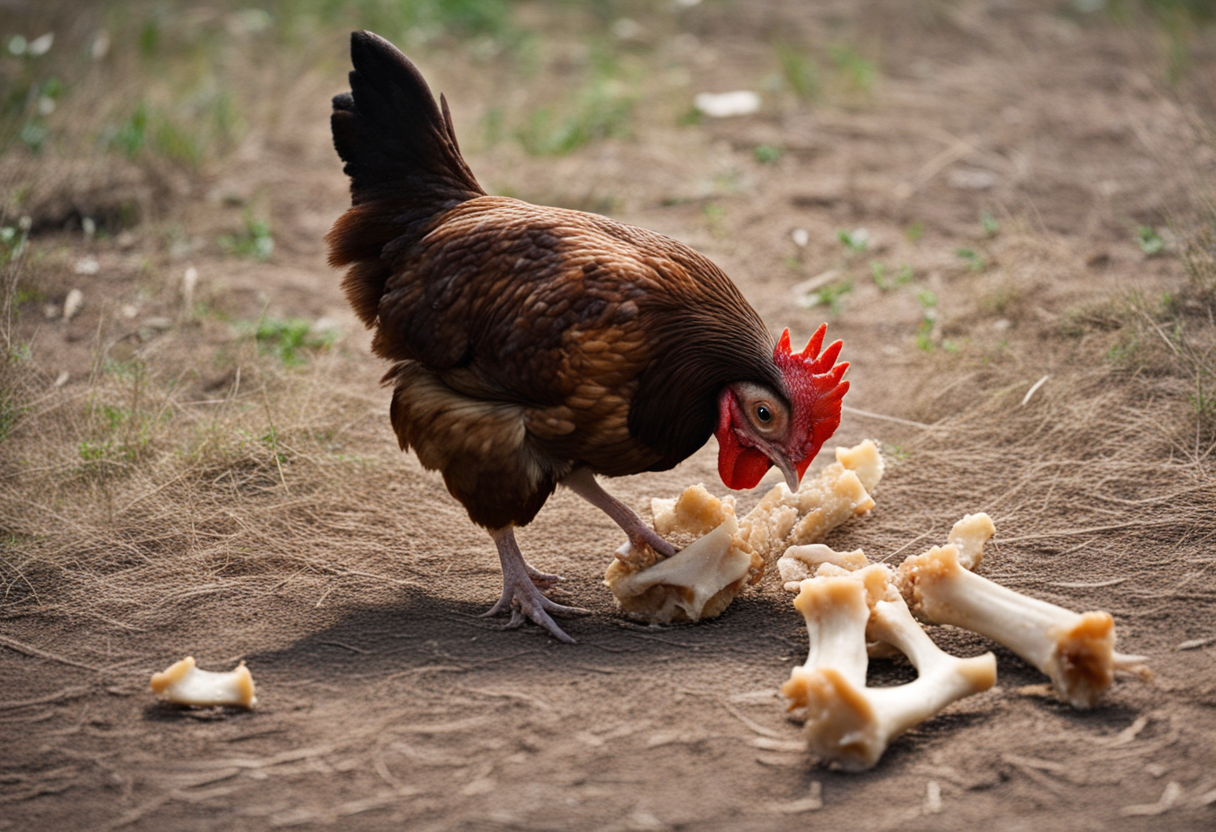
Raw meat scraps seem like great treats, but uncooked beef, pork and wild game often contain nasty pathogens.
Germs like Salmonella and E.
Coli easily taint raw meat and organ meats.
Feeding contaminated pork products poses risk of parasites and trichinosis too.
And while chickens will snack on small mice and bugs naturally, their systems aren’t built to handle digesting large amounts of animal proteins well.
Even their own species’ raw chicken should be avoided since salmonella is so widespread in commercial poultry operations.
Cooked chicken free of bones won’t immediately kill them, but does pose long term health issues since it offers zero nutrition – basically junk food.
For best safety and nutrition, avoid feeding chickens any raw meat or meat bones at all.
Spoiled Produce
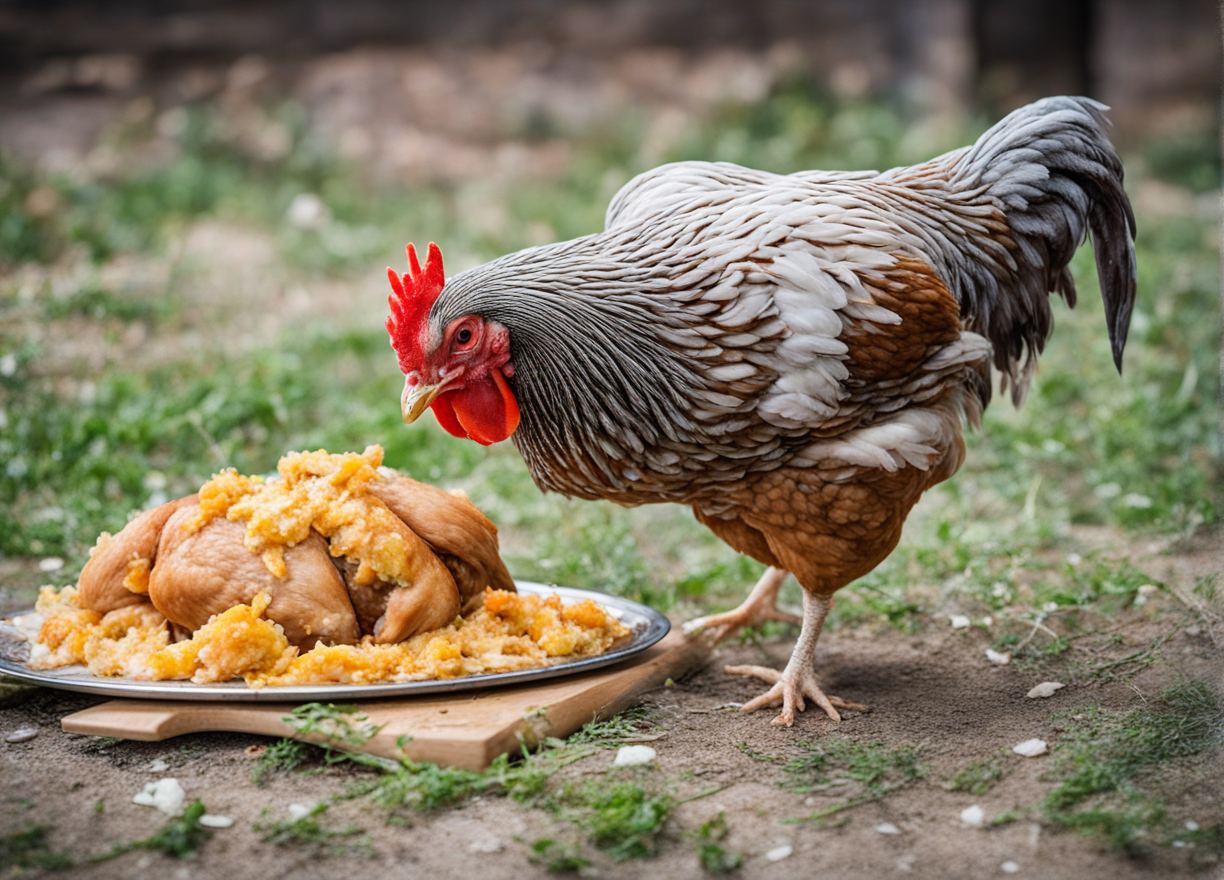
As backyard flock owners we’ve all had that impulse to toss chickens wilted veggies or leftovers that are past prime.
However rotten, moldy or slimy produce can contain dangerous mycotoxins, bacteria and organic compounds toxic to chickens over time.
A common culprit is salmonella, which readily grows on dying plant matter and produce gone bad.
Chickens carry a small natural load of salmonella already, so ingesting more from tainted food makes them sick.
Their digestive tracts also can’t break down the natural fungi and toxins some molds release either.
Even produce that looks fine but smells a little “off” can have microbes growing – trust your nose!
When in doubt, don’t chance it – compost don’t feed is a good motto for questionable produce.
Raw Legumes

Beans, lentils, peas and other legumes are great sources of protein and fiber for humans.
However, uncooked pulses aren’t safe for chicken consumption at all until prepared properly.
Raw beans including soy contain hemagglutinin or phytohemagglutinin, naturally occurring compounds that act as toxins and enzyme inhibitors.
These substances interfere with amino acid and protein absorption through chickens’ intestinal walls when consumed raw.
Kidney beans in particular have an especially high phytohemagglutinin content, and can rapidly cause death when eaten uncooked.
Even green beans, english peas, lentils and other veggies shouldn’t be given dried until rendered digestible through lengthy boiling or sprouting.
If you want to share the nutrition of legumes, make sure any beans are fully cooked from a can or bag first.
Green Potato Skins
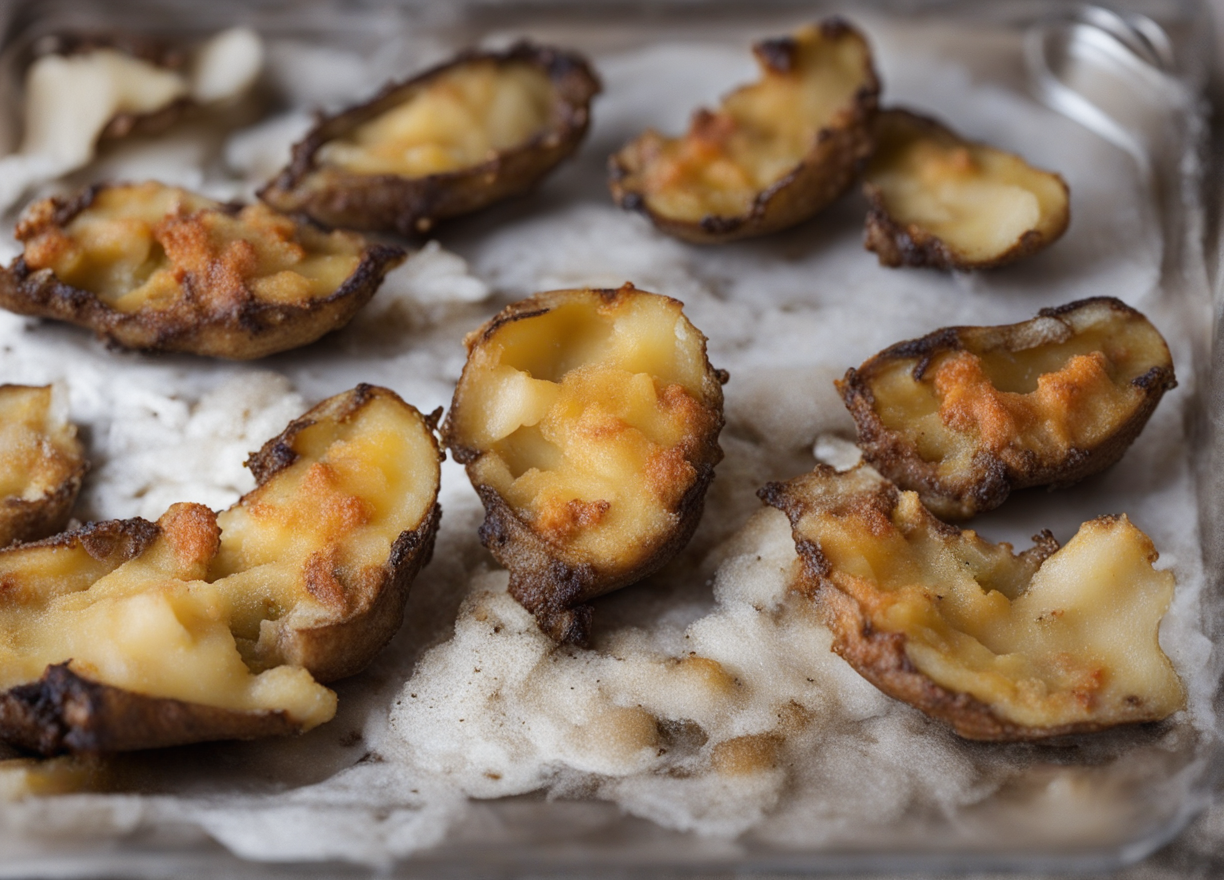
We all know green looking potatoes or sprouted spuds shouldn’t be eaten.
The same goes for chickens – that green color under the skin means concentrated levels of glycoalkaloids.
Compounds like solanine and chaconine cause paralysis, trembling, slowed breathing, convulsions and even death at high dosages.
Poisoning sets in quickly as soon as green potato parts are ingested.
Even if the potato itself looks fine, the sprouts and eyes that grow tend to concentrate the toxic alkaloids too.
Before feeding any spuds to your flock make sure you peel the area thoroughly to remove all green tinged skin.
Actually better yet is to skip peels entirely and cook the interior potato flesh only to feed safely.
Dry Cat Food
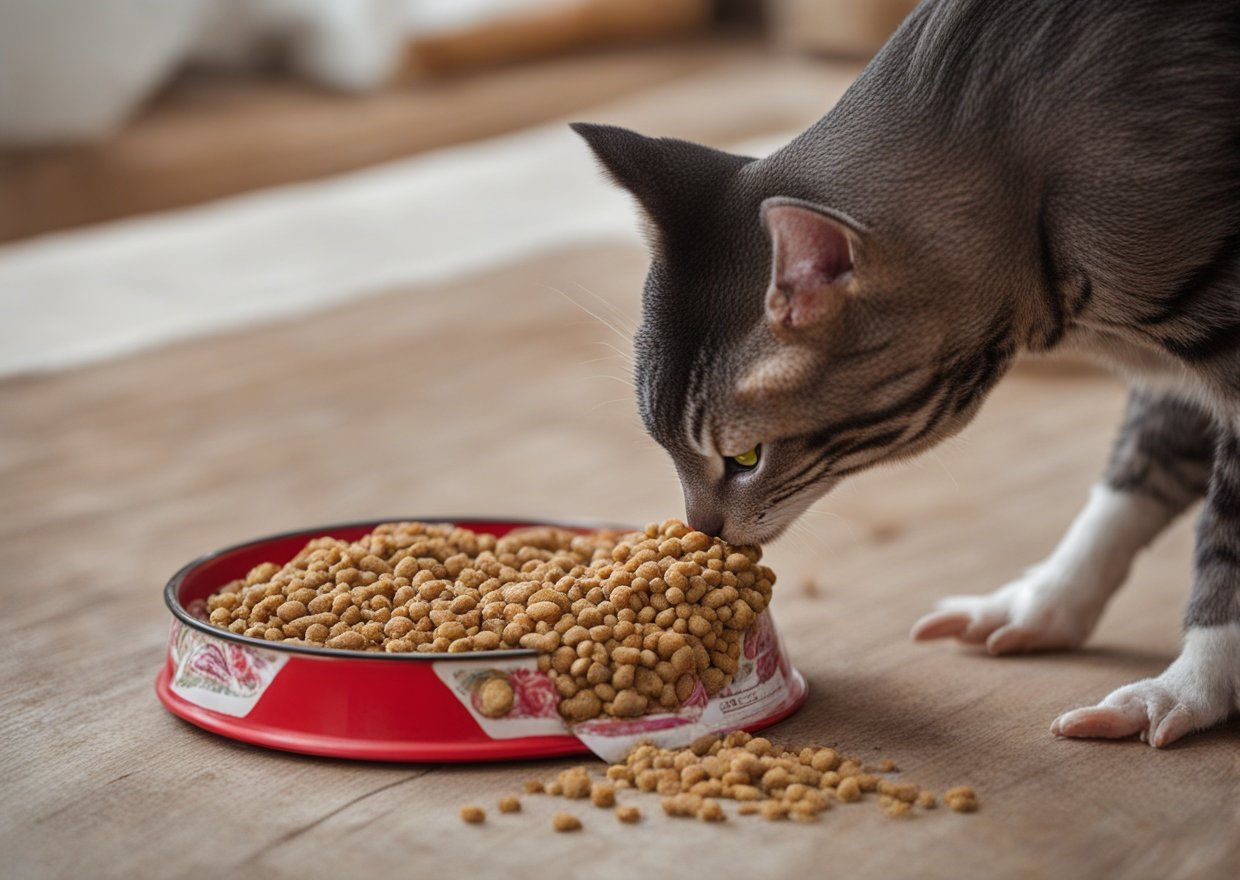
Many backyard flock owners also have cats that they leave food out for on the porch or mudroom.
Chickens love protein-rich tasty cat food, so they quickly learn to sneak bites whenever we leave bags open.
However, commercial cat diets are extremely high in protein levels – even the grain-inclusive kinds.
Most formulated especially for obligate carnivores like cats with higher meat content.
Feeding dry cat food long term taxes chickens kidneys leading to visceral gout and death over time.
The richer foods also aren’t balanced with the vitamins, minerals and amino acids chickens specifically need for egg production.
Plus medications added into some prescription or veterinary cat foods build up to toxic levels in chickens as well.
Chocolate

We all know chocolate candy and cocoa powder are dangerously toxic for dogs.
Well, turns out chickens can’t tolerate chocolate treats either without getting sick.
Chocolate’s dark brown color comes from antioxidant compounds called flavonoids concentrated in the cacao bean.
Two troublemakers for chickens are the bitter stimulants theobromine and caffeine.
Their systems lack efficient liver enzymes to metabolize these chemical relatives found in chocolate.
Eating chocolate leads to rapid breathing, irregular heart rates, tremors and even sudden death in chickens.
No chocolate candy, sweets, syrup, cake or pudding for chickens – it’s too risky!
Raw Rhubarb Leaves
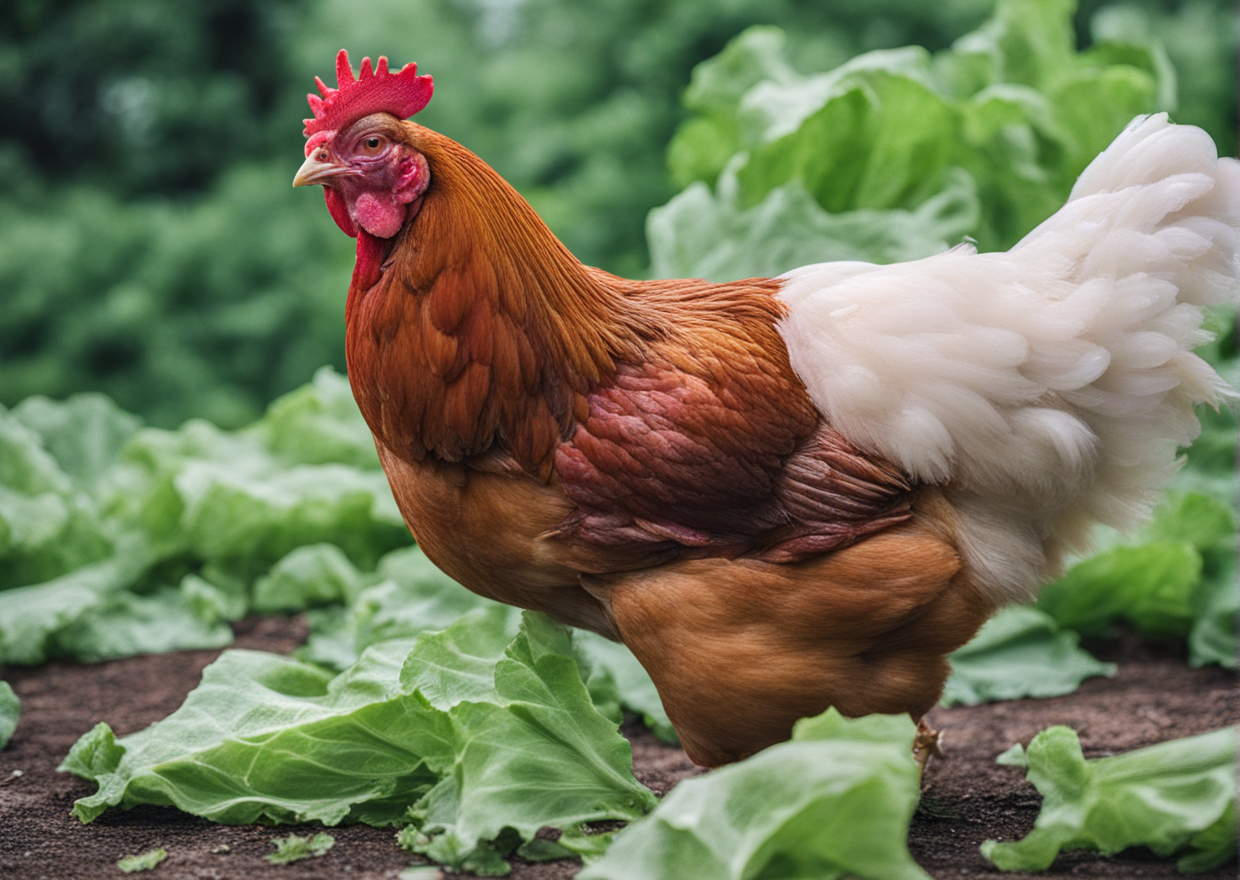
Rhubarb stalks make tart, healthy spring treats chickens love to peck at in the garden.
However while rhubarb stems are fine to eat after cooking them down to remove oxalates, the big green leaves are toxic raw.
All parts of the rhubarb plants contain measurable oxalic acid, concentrated most densely in leaf blades.
Oxalic acid binds with calcium to form rough calcium oxalate crystals damaging to soft tissue in the throat and digestive tract.
Ingesting oxalates also causes systemic calcium deficiency, kidney dysfunction, appetite loss and weakness.
With relatively little oxalates needed to poison per body weight, rhubarb leaf toxicity builds up fast in light-weight chickens.
Symptoms like lethargy and seizures begin quickly after chickens start sampled the tempting large leaves.
Only the red and green juicy stalks should be fed, not leaves which must be removed entirely from the plants first.
Raw Potatoes

We talked about why you should never feed green sprouted potato skins to chickens already.
However even normal looking white, yellow or purple potato flesh poses risks when eaten completely raw too.
In additional to solanine glycoalkaloids, all nightshade vegetables contain enzyme disruptors that inhibit digestion.
Lectins, protienase inhibitors, and other antinutrients interfere with nutrient absorption in the gut when consumed raw.
Plus excess resistant starches and complex carbs in potatoes ferment in the digestive tract causing bacteria overgrowth.
Diarrhea is common, but more seriously impacted swollen ceca or crop are seen long term.
For safety feed only fully cooked potato dishes like mashed, baked or boiled potatoes to your flock.
Household Chemicals
Chickens peck and ingest anything colorful from their surroundings.
But pesticides, automotive fluids, batteries and other hazardous waste can poison them.
Make sure to properly dispose of chemical products away from livestock access.
Nightshade Plant Parts
Most gardeners know to keep nightshade family plants away from impressionable little kids.
Tomatoes, eggplants, peppers, potatoes and goji berries all contain toxins called glycoalkaloids concentrated heavily in leaves, stems and unripe fruit.
Particularly potato plant leaves and berries pose extremely high solanine poisoning risks.
However eggplant, tomato and pepper tops also contain other alkaloid nerve and digestion inhibitors that build up over time.
Even sweet potato vines are suspect, containing unknown digestion-resistant proteins and saponins.
While ripe nightshade fruits/tubers eaten sporadically seem fine health-wise, better to err on the side of caution with plant parts.
Fence off garden beds so leaf litter and foliage don’t fall into chicken enclosures as fallback feed.
Chemically Treated Plants
It’s very tempting to rake up grass clippings, deadhead perennials, and trim back brush to add greenery to chicken pens.
However anything sprayed recently with insecticides, fungicides, or weed killing herbicides poses a real risk.
Chemical residues linger for long periods on the waxy cuticle layer of most plant leaves and stems.
Compounds like organophosphates and carbamates are highly toxic to chickens but tasteless and odorless.
Over time, low level exposure takes a toll through the bioaccumulation of chemicals eaten on sprayed plants.
Neurological damage, organ failure, severe illness and death occur much faster in small birds than larger livestock due to lower body mass.
Whenever possible, avoid spraying around chicken pens, and let clippings fully compost before feeding as mulch.
Venomous Insects
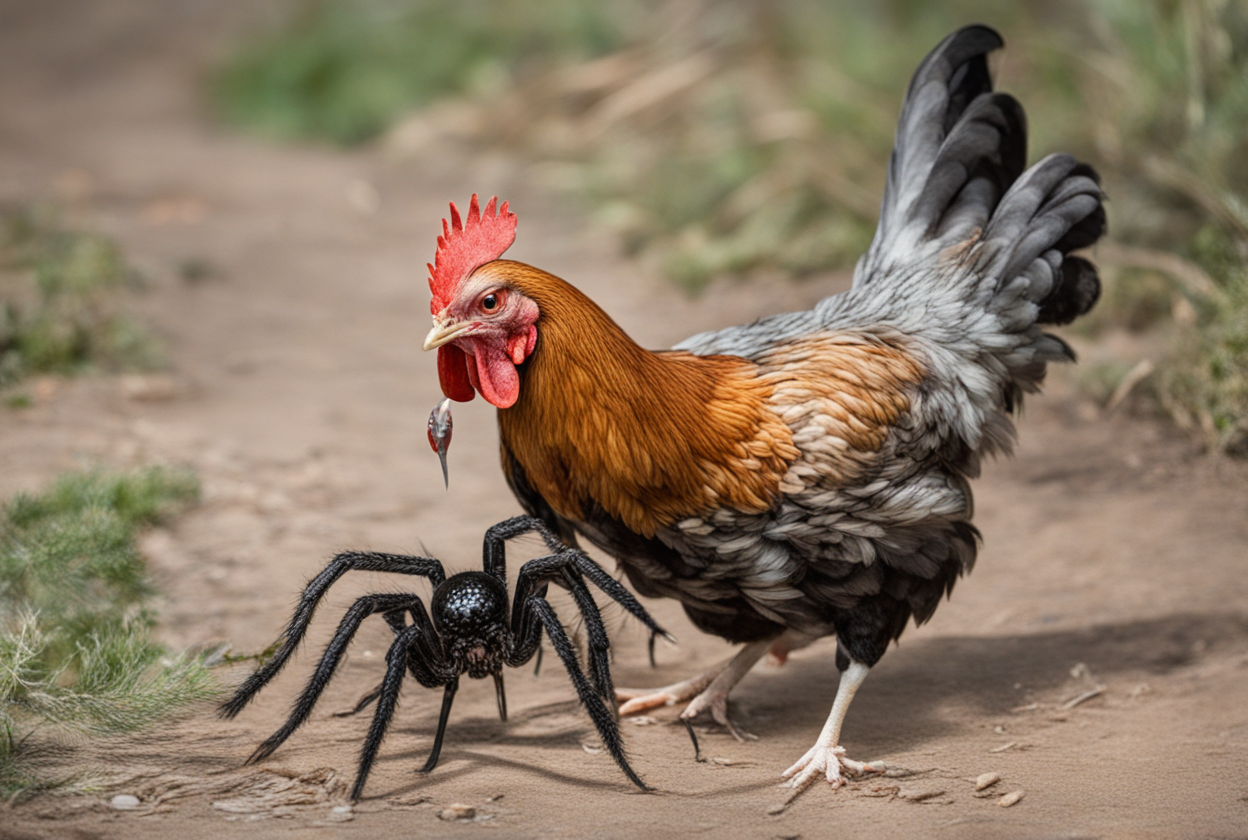
One benefit of free ranging chickens is put to work controlling bugs and larvae around the homestead naturally.
However, some insects like wasps, yellowjackets, hornets and fire ants are too hazardous for chickens to kill and eat.
Angry swarms of stinging insects prompt painful swellings and allergic reactions in exposed thin facial skin.
Their venom can also cause airway constriction, tissue necrosis, seizures and death depending on dosage.
Colonies of ants like fire ants inflict dozens of burning bites releasing alkaloid venom with each sting too.
While adult chickens may unsuccessfully get away, chicks and unhatched eggs are more vulnerable to attacks.
Use appropriate insecticidal powder/spray if hives or nests are spotted, and keep birds away from areas being treated.
Compost Pile Scraps
Overeager flock members will stick their heads directly into any opened compost piles given half a chance!
However, backyard compost bins often collect all kinds of things we shouldn’t be feeding chickens.
Citrus fruits, onion ends, garlic peel, bell pepper tops, moldy strawberries, corn cobs and other garden odds and ends tossed on the pile may appeal to them.
However acidic citrus juices can promote crop infections.
Alliums like onions and chives can cause hemolytic anemia.
And food leftovers may contain unseen mold, which releases dangerous mycotoxins.
Take care to set up compost areas away from main chicken access, using secure lids and containment to avoid having them aggressively feast inside.
Avocados
Avocados seem like a harmless healthy treat for chickens given their high nutrient density and beneficial fats.
However the pits, skins, leaves and bark of avocado trees contain persin toxin horses, cattle, birds and rodents struggle to metabolize.
When chickens eat avocado parts, the fungicidal persin compounds interfere with cardiac muscle function and fat metabolism over 24-48 hours.
Breathing difficulties, fluid accumulation around the heart, abdomen and lungs eventually occur, which can easily turn fatal.
Birds have been discovered dead under wild avocado trees where they’ve scavenged fallen fruit and bark.
The fleshy part eaten in small quantities probably won’t immediately poison chickens.
For safety though best to deny chickens access to avo parts whenever possible.
Alcohol/Caffeine
It seems innocuous enough to toss household beverage leftovers like beer, wine or coffee into the chicken pen for recycling.
However, alcohol and caffeine act as toxins once consumed as chickens completely lack the digestive enzymes to break them down properly.
Without being adequately metabolized and excreted from their systems, the effects build up to dangerous levels incredibly rapidly.
Hard liquor is most potent due to higher ethanol percentages, but even fermented beers pose substantial threats over time through liver and neurological damage.
And while coffee grounds seem useful as fertilizer nitrogen sources, the residual caffeine acts as a dangerous neurotoxin prompting anxious behavior, seizures, cardiac arrest and potential death in dosed birds.
Never let pet birds like parrots near alcohol either for the same lethal reasons!
Pickle Juice & Vinegar
It seems like chickens might enjoy the sharp tang of vinegar-heavy marinades, dressings and brined products like pickles or sauerkraut.
However, the acetic acid, citric acid and traces of alcohol interact dangerously when ingested by birds with sensitive digestive systems.
The low pH itself can burn and irritate fragile throat and crop tissue linings promoting secondary infections.
And even though fermented foods offer living probiotics, excess strains leads to microbial imbalance causing nasty diarrhea pretty quickly.
For safety avoid giving chickens access to acidic pickled products and stick to fresh whole foods like garden fruits and veggies instead.
Their systems aren’t designed to handle highly acidic foods well even though small tasting portions may not cause immediate issues.
Wild Mushrooms
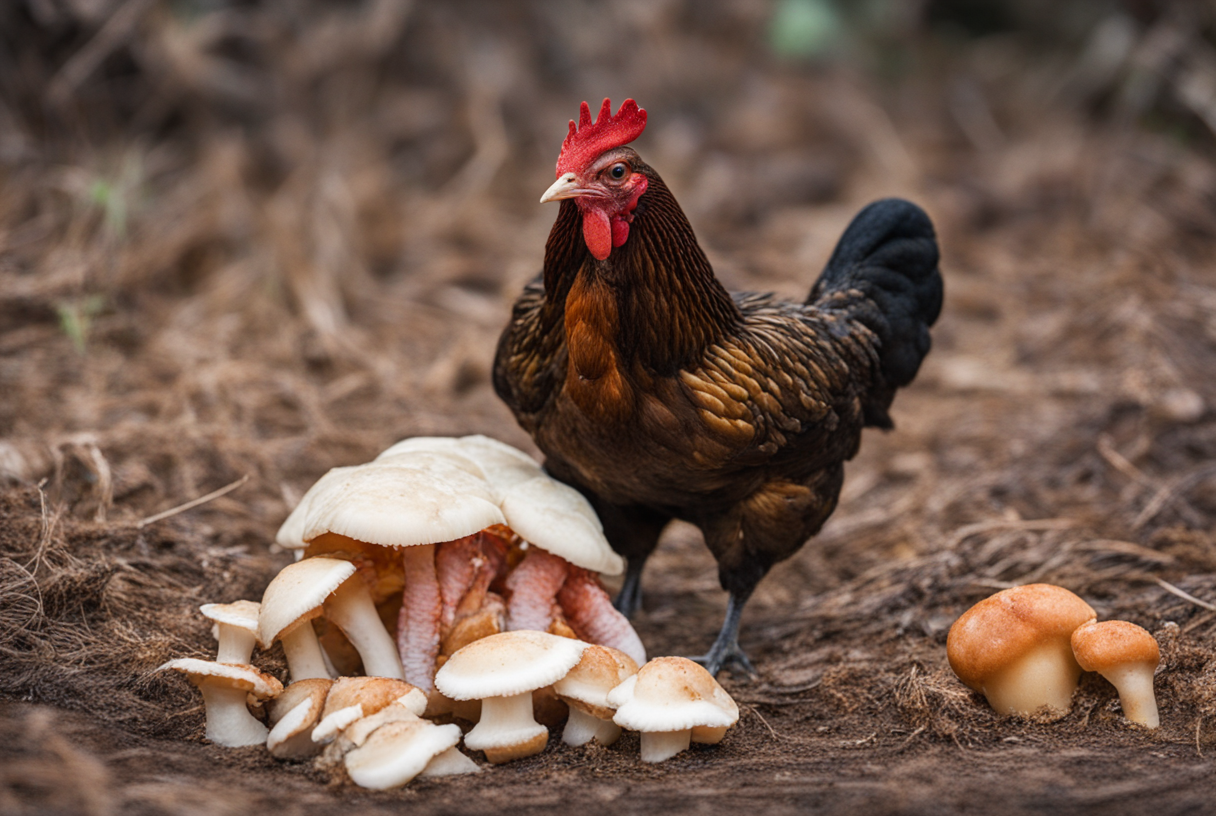
Mushrooms and tasty fungi often opportunistically grow in the damp, shady areas chickens love digging through.
The problem is fowl don’t intuit well which wild mushrooms scattered around the yard or coop perimeter happen to be toxic types and which are safe varieties.
Many poisonous species look similar initially to benign mushrooms until liver and neurological damage set in too late.
Deadly Destroying Angels, Autumn Skullcaps, Podostroma cornu-damae, Galerina marginata and several other species don’t show toxicity or bitterness clues chickens can detect ahead of time.
Without knowledge of mycology we can’t easily tell either, so best not to chance stumbling across death caps or toxic LBMs (little brown mushrooms) around the homestead.
Stick to occasionally feeding raised gourmet store-bought mushrooms instead, avoiding anything wild gathered.
Raw Eggs

It may seem ironic to say don’t feed chickens eggs, but uncooked eggs do pose risks even to the ladies laying them.
Both egg shells and raw egg whites/yolks can be contaminated by bacteria within chickens already or from foreign sources.
Common bugs like Salmonella Enteritidis, E.coli, Campylobacter, Staphylococcus and Listeria all thrive on undercooked egg contents.
Chickens often don’t display illness symptoms immediately, meanwhile these pathogens spread quietly between flockmates and packaging surfaces.
Over time illness manifesting as diarrhea, vomiting, drop in egg production or even sepsis occurs.
Routine environmental and egg washing programs help significantly, but cooking any discarded or broken eggs is smart.
Raw Sweet Potatoes

Raw sweet potatoes contain enzyme inhibitors that hamper digestion.
Toxin compounds require cooking through baking/boiling to fully break down before feeding.
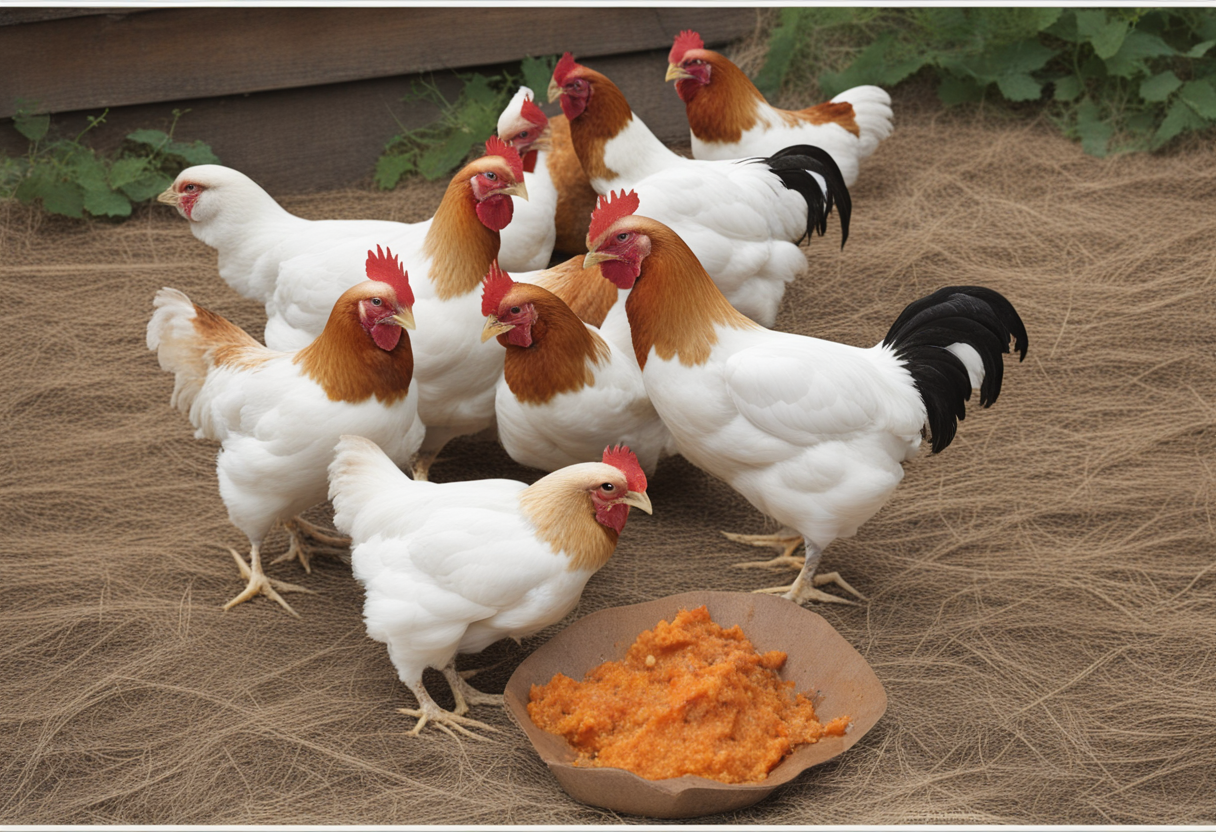
Don’t let chickens nibble garden sweet potato vines.
Raw Leftover Yolks
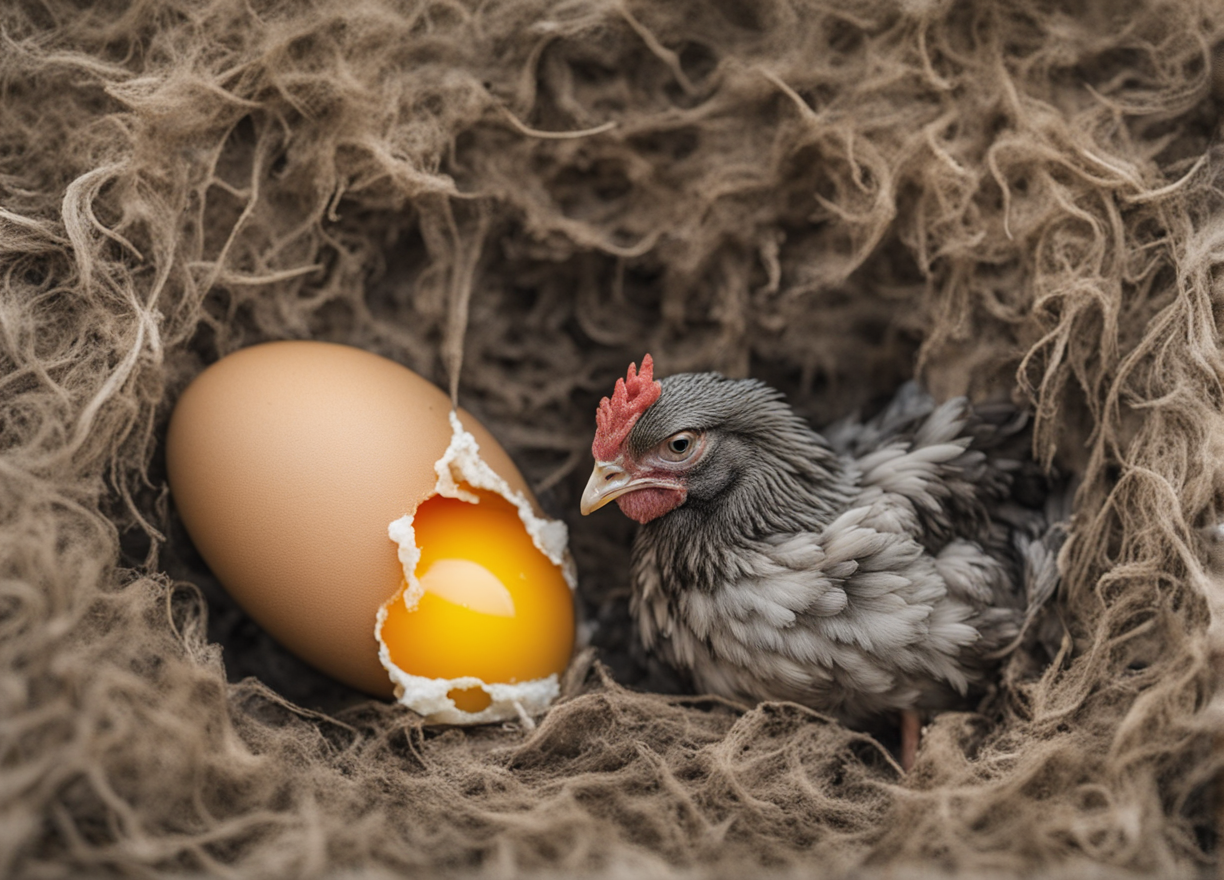
Raw egg yolks pose a huge salmonella contamination risk even from chickens’ own eggs.
Always cook leftovers fully before refeeding rather than offering bits from undercooked recipes.
Citrus Peels
Feeding chickens the fleshy juicy segments and nutritious inner fibrous citrus pulp seems harmless enough for flock enjoyment and vitamin C supplementation.
However letting chickens freely access and consume whole unpeeled fruits long term poses notable health threats.
Beyond the inner rind where beneficial bioflavonoids reside lies the tough colorful oil-rich exterior peel layer of citrus skins.
This packing rind contains high densities of aromatic acids, waxes and limonene hydrocarbons used by citrus plants as natural insect repellants.
When ingested, these protective compounds irritate sensitive crop tissues already compromised by the fruit’s extreme acidity.
The rinds fail digesting properly, instead obstructing delicate throat and upper GI tract architecture not designed appropriately to grind such rough fibrous matter.
All citrus fruits pose this obstruction risk, but in particular the loose baggy peels of tangerines, clementines and mandarins are most problematic when eaten.
Choking hazards plus tissue chemical burning set the stage for prolapse, infection and reduced feed intake.
Share citrus fruits only after careful peeling first, then chopping remainder into bite-sized pieces to safely maximize nutritional benefits for chickens while avoiding needless harm.
Fire Ants
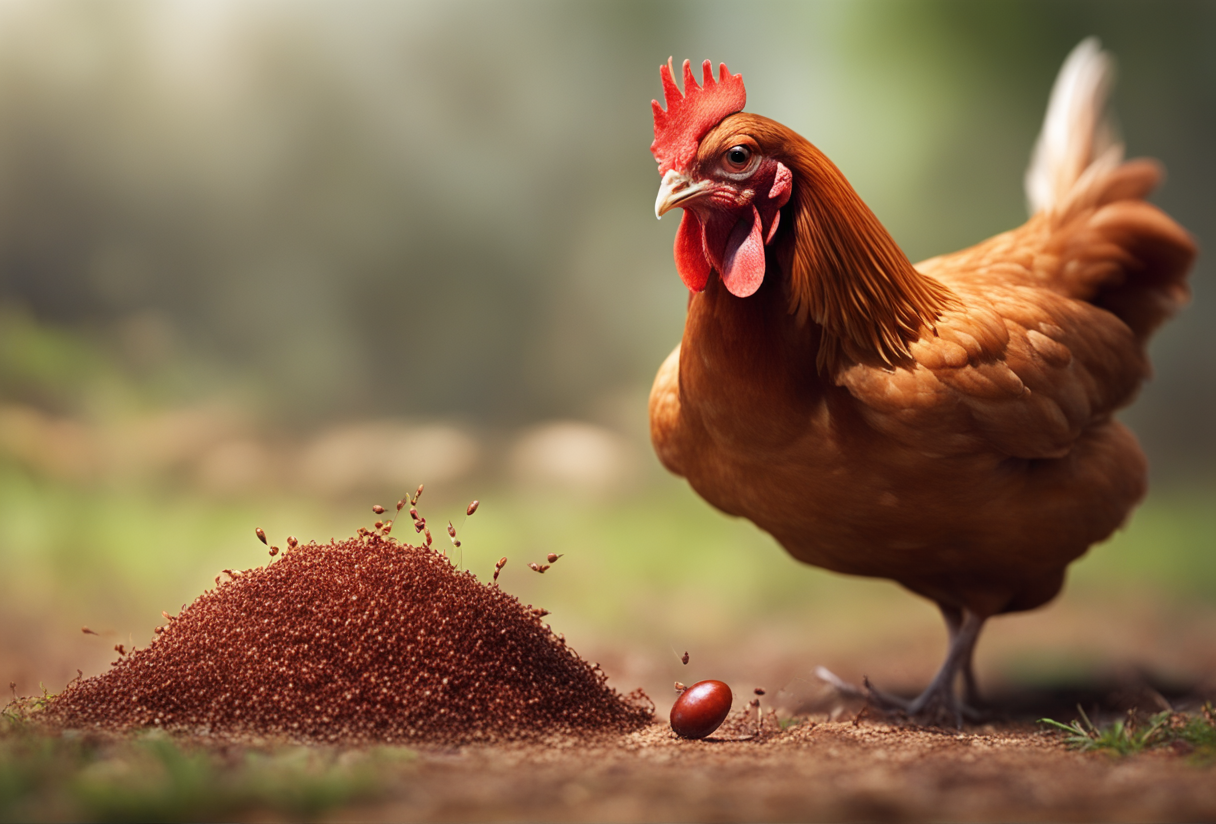
Bright red fire ants seem like an innocuous enough insect at first glance while out free ranging.
However, these aggressive ants swarm over stationary food and moisture sources – including sleeping chickens!
Attracted to protein and fatty acids, fire ants relentlessly bite and sting chickens’ delicate facial skin and ventilation holes by the dozens.
Their sharp mandibles pierce flesh while injected alkaloid venom causes immediate searing pain and burning.
Being pinned down by endless attacking ants, chickens often asphyxiate from respiratory distress as the stings swell tender membranes closed.
Plus, the toxin destroys red blood cells leading to anemia and also circulates destroying liver and kidney tissues over the next few days.
Fire ants will ruthlessly kill baby chicks and unravel full nests of hatching eggs if left to invade coops uncontained.
Adult birds experience painful wounds prone to infection and if not treated quickly, die from organ failure.
Use fast-acting ant killer powders and baits around the run perimeter to eradicate colonies.
Prevention is key to help protect fragile chickens from fire ants’ painful attacks!
Raw Potato Skins
We’ve emphasized the dangers of feeding chickens moldy produce or vegetation sprayed with herbicide/pesticide residues already.
However another very common backyard hazard exists in the form of lawn and garden waste like potato peels.
You hopefully already know to steer clear of potato plant debris and green tubers containing solanine glycoalkaloid compounds.
But did you know all potato skins and eyes concentrate additional anti-nutrients and toxin precursors?
Enzyme disruptors interfere with digestion while natural insecticides aimed at discouraging pests can accumulate to dangerous levels within feathered bodies over time.
For safety reasons, please avoid tossing fowl potato jackets, peels or water lentils without thoroughly boiling/cooking them first to neutralize.
Compost Pile Contents
Overeager chickens given the opportunity delight digging directly into open compost piles.
However, collected fruit and vegetable culls can contain a mix of foods unsafe for their consumption.
Citrus peels, allium ends, hot peppers, rotten vegetation and other tossed organic waste builds up over time.
The trace amounts of alcohol, fermented sugars and decomposition byproducts contributes to upset digestion when consumed.
Make sure compost bins stay securely closed off from poultry yards where possible to avoid illness temptation and unnecessary veterinary bills!
Dried Fruit with Sulfur Dioxide
Dried fruits like raisins, cherries, pineapple, banana, apricots and mango make useful training treats chickens go crazy for.
However astute owners should examine packaging first for added preservatives like sulfur dioxide before purchasing.
This sulfur salt gets added by processors to retain color and texture, while doubling as microbial control getting released from sulfite salts as a gas.
Once ingested by chickens, proteins present bind irreversibly disabling vital enzyme systems needed for oxygen transport and metabolism.
Toxicity symptoms then emerge as lethargy, diarrhea, breathing issues, collapse and bluish combs/wattles indicating insufficient blood oxygen circulating.
Avoid sulfured dried fruits in favor of unsulfured organic brands or air/sun-dried versions whenever possible.
Caffeine Drinks
Leftover coffee, tea and energy drink dregs seem harmless enough to pour out as free choice treats in coops and runs.
However the caffeine and stimulant ingredients completely disrupt chickens unfamiliar with biologically processing the addictive drugs.
Rapidly absorbed through digestive membranes, metabolic pathways fail breaking down theobromine, theophylline and caffeine molecules.
Nervous system stimulation causes hyperactivity, appetite loss, heart arrhythmias, diarrhea and potential seizures.
All human caffeinated products should stay far away from chicken access for their health safety.
Hardware Scraps
Chickens use their beaks to interact and explore anything colorful, shiny or remotely edible seeming in their environment.
Common things like nails, metal caps, pennies, bolts, and wire shreds appeal as gizzard grit candidates.
However all hardware scraps pose major health risks including tearing internally and delivering heavy metal toxicity over time through any ingested bits.
Even iron supplements can build up too much absorbed iron levels causing tissue damage.
Prevention involves properly containing or disposal of any construction debris instead of letting blow into runs.
Sugary Foods
It’s hard resisting tossing chickens the occasional sugary treat leftover from human snack time.
However, excess refined sugars severely disrupt digestive tract microbe ratios in the long run.
The quick carbohydrates also feed harmful pathogenic organisms that release toxins and damage intestinal walls over time.
Concentrated sweeteners like high fructose corn syrup found in candy and soda pose the worst threats.
But even supposedly healthy options like agave, coconut sugar and evaporated cane juice provide empty nutrition and calories.
Avoid sharing desserts, sweet drinks and sugary foods with backyard chickens for optimal health.
The #1 Silent Chicken Killer 💀🐔 Is Your Chicken Feed Secretly Slaughtering Your Flock?
You’ll never guess the most toxic thing backyard flock owners unknowingly feed.
It hides stealthily right under our noses, getting tossed around coops daily.
I’m talking about.
moldy chicken feed!
That’s right – feed gone bad with fungal growth is utterly disastrous for chickens over time.
While molds themselves produce hazardous toxins that accumulate, they also spell major trouble indirectly.
Mildewed feed loses crucial nutrient value as vitamins break down.
Yet hens eagerly still eat it if we don’t remove spoiled feed first.
So not only are chickens ingesting high mycotoxin loads leading to illness, they also suffer malnutrition from lack of quality nutrition!
It’s a double blow that spells disaster through immunosuppression, diarrhea, appetite loss, and steep decline in egg production.
Always stay vigilant inspecting feed storage bins for moisture and toss old feed at first sight or whiff of mold.
Your feathered ladies will thank you by staying happy and healthy long term!
Top 10+ Worst Things to Feed Your Chickens
| Hazard Level | Why It’s Harmful | |
|---|---|---|
| Moldy Feed | 10 | Contains dangerous mycotoxins and fungus toxins over time |
| Raw Meat/Bones | 10 | Risk of bacterial contamination from pathogens like Salmonella and E. Coli |
| Salty Foods | 9 | Causes dehydration, kidney failure, heart issues in chickens |
| Spoiled Produce | 9 | Harbors bacteria, molds and toxins dangerous to chickens |
| Raw Legumes | 9 | Contain enzyme inhibitors and lectins stopping nutrient absorption |
| Green Potato Skins | 9 | Concentrates the glycoalkaloid compounds solanine and chaconine poisonous to chickens |
| Dry Cat Food | 8 | Too high in protein, fat and minerals for chickens to process |
| Chocolate | 8 | Contains toxic caffeine relatives – theobromine and theophylline |
| Raw Rhubarb Leaves | 10 | Oxalic acid in leaves causes liver damage and calcium deficiency |
| Rotten/Moldy Items | 10 | Visible or invisible mold growth releases hazardous mycotoxins |
| Raw Potatoes | 8 | Contain enzyme disruptors, toxins and alkaloids poisonous to chickens until cooked |
| Stale Feed | 8 | Degrades nutrients over time and grows dangerous invisible mold |
| Nightshade Plants | 8 | All parts contain toxic glycoalkaloids causing weakness and death |
| Chemical Residues | 8 | Insecticide, herbicide and fungicide residues linger on plant materials |
| Fire Ants | 7 | Painful stings and venom can prompt dangerous allergic reactions |
| Compost Waste | 7 | May contain moldy food scraps, vegetation, onions, citrus etc toxic over time |
| Avocados | 7 | Persin compound in skins, pits causes heart/lung issues |
| Caffeine Drinks | 10 | Caffeine/alcohol build up as dangerous toxins causing seizures, arrhythmias |
| Vinegar | 7 | Irritates digestive tracts, alters gut pH leading to illness |
Have You Poisoned Your Flock? Share Your Worst Chicken Feeding Fails
I’d love to hear if you’ve had any interesting experiences feeding your flock the wrong foods.
Have your chickens ever turned up their beaks at something you offered them?
Did you accidentally cause any feather-ruffling tummy troubles?
Help Others Avoid Disaster: Share Your Worst Chicken Feeding Snafus.
Connect with me on FB & Let’s swap tales of the wackiest chicken snacks gone wrong…
And I’ll feature them in this post!
Between us all, we’ve probably seen some fowl things end up in fowl stomachs!
To be continued….
Yours,
